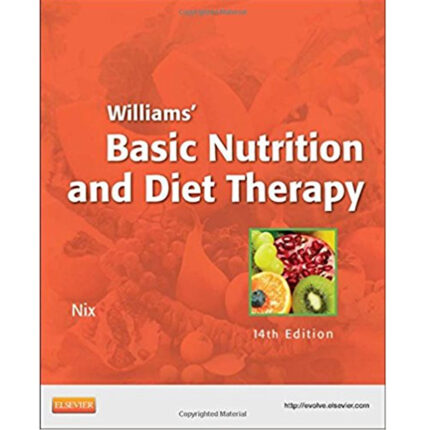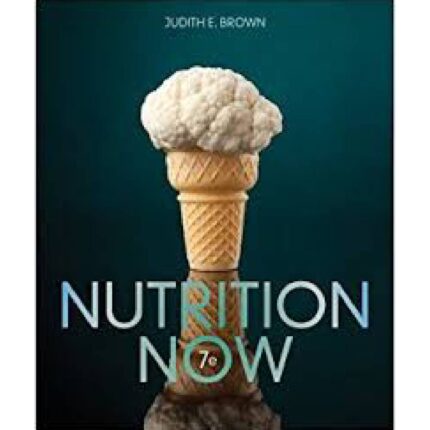Krause Food Nutrition Care Process 13th Edition By Mahan – Test Bank
Mahan: Krause’s Food and the Nutrition Care Process, 13th Edition
Test Bank
Chapter 11: Overview of Nutrition Diagnosis and Intervention
MULTIPLE CHOICE
1. Which of the following does NOT follow the guidelines for proper documentation in a medical record?
a. Add entries in chronological order.
b. Use correction fluid to make corrections.
c. The first word of every statement should be capitalized.
d. Include the date, time, and service with each entry.
ANS: B
Because the medical record is a legal document, alterations that deface or make changes that cannot be tracked are not allowed. When a mistake is made, correction fluid should not be used. Instead, a single line is drawn through the mistake, the correction is made, and it is acknowledged by initialing and dating the correction.
REF: pp. 260, 266
2.Which of the following is NOT a documentation style for entries into a medical record?
a. ADIME
b. POMR
c. EMR
d. SOAP
ANS: C
EMR is the electronic medical record; it is not a documentation style. POMR refers to problem-oriented medical record that organizes charting according to the patient’s primary problems. The two most common documentation styles available for use in the medical record are the SOAP (subjective, objective, assessment, plan) and ADIME (assessment, diagnosis, interventions, monitoring, evaluation).
REF: p. 260, 266
3.Which documentation style has been proposed to reflect the nutrition care process?
a. PES
b. focus charting
c. SOAPIER
d. ADIME
ANS: D
The Nutrition Care Process includes four components: nutrition assessment (A), nutrition diagnosis (D), nutrition intervention (I), and nutrition monitoring and evaluation (ME). PES is another term for the nutrition diagnosis statement and refers to problem, etiology, and signs and symptoms. Focus charting is a documentation style based on the identification of and then charting in response to problem occurrence. SOAPIER is an extension of SOAP that includes intervention (I), evaluation (E), and revision (R).
REF:pp. 253, 254, 260
4.Which of the following requires that health care providers ensure the protection of their patients’ privacy?
a. TJC
b. MCOs
c. HIPAA
d. CMS
ANS: C
The Health Insurance Portability and Accountability Act (HIPAA) of 1996 is the federal law that called for improved efficiency and privacy in regard to the use of electronic transmission of patient data. Through this, patient information is considered private and confidential, and all health care providers are responsible for ensuring this. The Joint Commission is a peer review organization that accredits health care organizations that are in compliance with minimum standards. Managed care organizations finance and provide care to subscribers of the service at a preset charge as a means of trying to control the costs of health care. The Centers for Medicare and Medicaid Services is the federal division responsible for the administration of Medicare, Medicaid, and HIPAA.
REF: pp. 258, 268
5.Which of the following identifies the essential elements and activities that should occur in a patient’s care?
a. Case management
b. Critical pathway
c. Utilization review
d. DRG
ANS: B
A critical pathway is used by health care providers to identify what activities should occur at times throughout a patient’s care. This is a key component of case management, which focuses on the achievement of patient-focused goals in the delivery of health care. Utilization review is a process of identifying and eliminating unnecessary health care treatments so as to provide the most cost-effective care. Diagnosis-related groups refer to a method of health care reimbursement established in the 1980s as a means of helping control health care costs.
REF: p. 268
6.Which of the following is a system of paying for the care of a patient based on their diagnosis?
a. Utilization management
b. Patient-focused care
c. Case management
d. DRG
ANS: D
Utilization management uses established standards to identify tests, procedures, and services in health care that have known benefits toward patient improvement. The utilization manager reviews the case management of a patient to ensure that only approved activities that will help the patient are being performed. Patient-focused care is organized around the concept that the patient is the focus of the health care team, and the patient ultimately makes the decisions in regard to health care. Case management is the overall management organized around the achievement of patient health care goals. DRG is a system of paying for the care based on the diagnosis of the patient.
REF: p. 268
7.Utilization management is
a. a system to protect personal health information.
b. a system of cost efficiency.
c. a critical pathway.
d. a medical staffing system.
ANS: B
Utilization management strives for cost efficiency by eliminating or reducing unnecessary tests, procedures, and services. HIPAA is a system for protecting personal health information. A critical pathway identifies essential elements that occur in a patient’s care.
REF: p. 268
8.In the hospital, _____ mL/day of fluid should be provided for the average healthy adult.
a. 500 to 800
b. 1000 to 1500
c. 1800 to 2500
d. 2500 to 3500
ANS: C
A fluid intake of 1800 to 2500 mL per day is equivalent to consuming 1 mL water per calorie consumed. Some medical conditions may require additional fluids, and others may require fluid restriction. Fluids may be provided in the hospital through oral intake and intravenously.
REF: p. 271
9.The nutritional value of the average clear liquid diet is
a. no protein and 500 to 700 kcal.
b. 5 to 10 g protein and 500 to 600 kcal.
c. 20 to 30 g protein and 100 to 1200 kcal.
d. 40 to 50 g protein and 500 to 700 kcal.
ANS: B
The clear liquid diet consists of foods such as tea, broth, carbonated beverages, clear juices without pulp, and gelatin. As a result, this diet is very nutritionally incomplete and usually only provides 500 to 600 calories and 5 to 10 g protein. Ideally, a patient should be transitioned to a more nutritionally complete diet as soon as the patient can tolerate more solid foods.
REF: p. 271
10.A newly admitted patient is observed to have poorly fitting dental plates. Which type of diet would be most appropriate for this patient?
a. General or regular house diet
b. Liquid diet
c. Consistency-modified diet
d. Diet increased in energy value
ANS: C
When a patient has poorly fitting dentures, it affects the patient’s ability to chew. Difficulties with chewing and swallowing are best accommodated by a consistency-modified diet. The regular house diet, although nutritionally complete, may include foods that the patient will have difficulty chewing and swallowing, and this may be reflected by a decreased or incomplete intake. Liquid diets tend to not be nutritionally complete, and in particular, they lack fiber. A person with poorly fitting dentures would need extra calories only in the instances when either increased energy needs are determined or there exists a concern in regard to the patient’s weight.
REF: p. 270
11.Which of the following has a negative influence on patient acceptance and intake of meals and food in the hospital?
a. Patient selection of menus
b. Improper food temperatures
c. Eating with others
d. Nurse’s communication of the diet
ANS: B
Poor acceptance of meals in the hospital may be caused by improper food temperatures, unfamiliar foods, changes in the eating schedule, the patient’s medical condition, or the effects of medical therapy. Having the option of selecting menu items, eating with others, and positive communications from nurses and other health care team members can help improve patient intake.
REF: p. 271
12.When providing nutritional care for the terminally ill patient, dietary restrictions
a. should be maintained throughout the illness.
b. are rarely appropriate and should not be used.
c. should be followed to the best of the patient’s ability.
d. should be focused on preventing disease progression.
ANS: B
When providing care for a terminally ill patient, the primary goals should be to provide comfort and quality of life. Dietary restrictions are usually implemented to prevent disease advancement; however, in the case of a terminally ill patient, using dietary restrictions will not necessarily promote quality of life. When providing nutrition care in these instances, it is more important to focus on aspects of nutritional care that can facilitate symptom and pain control.
REF: p. 272
13.Which of the following identifies a patient’s health care preferences in regard to end-of-life issues?
a. Discharge planning
b. Disease management
c. Case management
d. Advanced directives
ANS: D
Advanced directives are legal guidelines established by a patient that designate personal health care intervention preferences or identify a person to make decisions when the patient does not have the capacity to do so. Discharge planning is a team approach to preparing for the continuity of health care after the patient leaves the hospital. Disease management is a disease-specific approach to preventing the progression of a disease while providing care in the outpatient setting. Case management encompasses discharge planning and disease management in regard to the achievement of patient health goals.
REF: p. 272
14.What is another name for the practice guidelines that define the appropriate and consistent care for a patient with a specific diagnosis or medical problem?
a. Standards of care
b. Critical pathway
c. Evidence-based practice
d. Discharge planning
ANS: A
Standards of care are the basis for providing consistent quality of care to patients within a particular health care institution. They act as the overall guide to the care. A critical pathway more specifically pinpoints when particular activities of care will occur during the patient’s time in the health care facility. Evidence-based practice refers to providing care based on the best, most successful practices in health care that have been demonstrated through research, consensus, or other evidence. Discharge planning prepares for taking care of the patient when the patient leaves the health care facility.
REF: p. 268
15.The Joint Commission requires the identification of nutrition risk of hospital patients to occur within
a. 12 hours of admission.
b. 24 hours of admission.
c. 48 hours of admission.
d. 24 hours of admission, except on the weekend.
ANS: B
Although The Joint Commission does not specify how patients should be identified for nutritional risk, all patients need to be screened for nutrition risk within 24 hours of admission, regardless of whether the patient is admitted during the week or on the weekend. Many hospitals accommodate this by including questions regarding nutrition risk in the initial nursing assessment performed on the patient. If the patient meets the hospital’s nutrition risk criteria, this is communicated to the clinical nutrition staff so that further nutrition assessment can be performed.
REF: pp. 258–259













Reviews
There are no reviews yet.